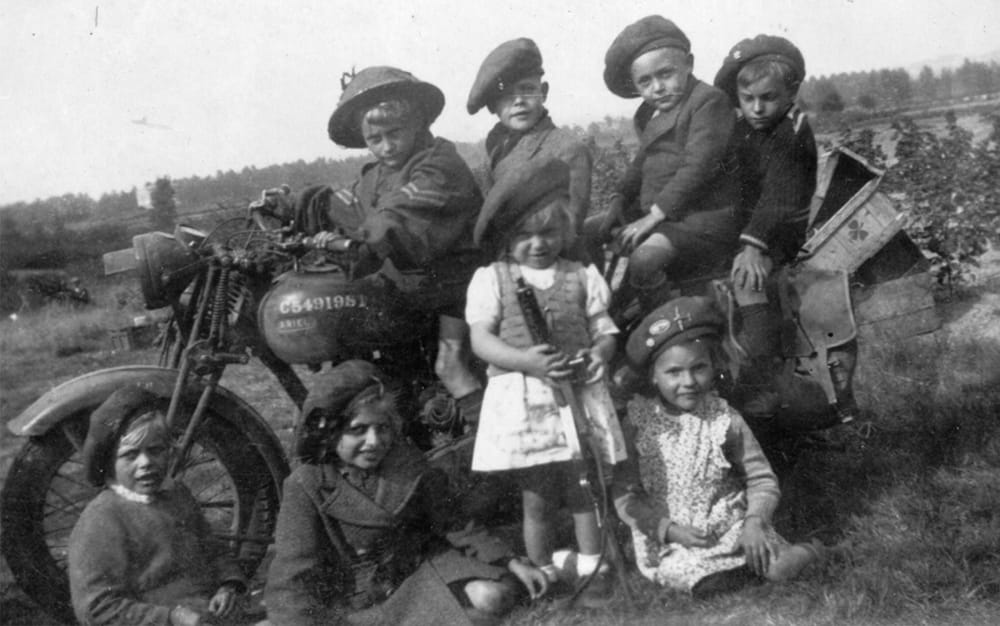Good morning All,
The rear dropouts on my 1947 M20 appear to have been butchered a little. The nearside hole, to which the rear stand was bolted to has been cut away for some reason. The bike currently has a centre stand which doesn't appear to be standard (I could nbe wrong!!) & it's really awkward to operate. I would like to reinstate the rear stand but will need to repair the area where it attaches, does anyone know what material the frame lugs are manufactured from? I'm hoping it's a steel forging.
Many thanks,
Gino.
email (option): gino_kerekes@yahooooo.co.uk
It's not unknown for the rear stand lugs to wear (The holes and stops) and sometimes brake off completely. It's why I lift my bikes carefully onto the rear stand and never stand on the foot rests to start the engine. I guess you can fabricate the broken area with mild steel or toughened stuff if it's weldable. This picture Henk sent me might help. Ron

email (option): ronpier@talk21.com
I'm not entirely sure what went on with the rear drop outs but it looks as though someone has decided to cut a little of them away. This has resulted in only half a mounting hole left on one side where the stand fits. Maybe it was all seized at one time and the PO decided to cut it off & do a centre stand conversion!!
That's great,
Thanks Ron.
email (option): gino_kerekes@yahooooo.co.uk
Last time I did a repair on the rear stand I did it like in the photos. I first made a disc that fitted the stand bolt and had the size of the piece I had to remove from the rear frame. I removed enough material to make the disc fit the frame and welded in to place.
You probably also have to repair the frame where the stand rests against when it's on the stand. This surface is often worn away giving the stand a weird angle that makes it hard to get it off the stand.
Henk



email (option): ahum@quicknet.nl
Thanks Henk,
That’s exactly how mine is broken.
I’m wondering if the lugs are cast if they broke in that manner?
Did you repair yours by welding the boss on?
Thanks,
Gino.
email (option): gino_kerekes@yahoooo.co.uk
I'm sure the metal is a good quality forging. But as Henk explained, when the stops ware, there can be so much strain on that area, it just rips it out. As I read it, Henk made the ring, then removed enough material from the frame so as to position the ring in the correct place, and then welded it in around its top side......Henk??
Ron
email (option): ronpier@talk21.com
We tried welding a cap over the missing end & it worked fine for about a year till an "Empire Star expert" showed us the "correct way" to start one and jumped onto the starter from about 20'.
Our mistake we thought it was a kick start pedal and apparently it is a leap start pedal.
In any case the stand bent & the patch broke free.
Repair 2 was to grind away enough material to weld in a tube section ( we used a high tensile nut) then grind the nut back far enough for the fork of the stand to slide through.
Seems to be holding and of course it has about 5 times the surface area to weld in so should be a lot more resistant to falling off.
Being a full round it should be a lot stronger than the cap used previously.
We left the thread i till it was welded in place so we could position it with a length of all thread so it ended up being true to the frame .
email (option): bsansw1@tpg.com.au
It are forgings not casting and they are usually very strong. The up and down bouncing of the rear stand, because of a weak spring, while riding causes most of the wear making the holes oval. The wrong angle the stand has when the surface of the frame wears away and the worn holes do the rest like with my frame. Kick-starting the bike on the rear stand also puts a lot of strain on the rear stand and the frame rear stand holes.
I did indeed weld the discs in place.
Henk.
email (option): ahum@quicknet.nl
Frame lugs were cast in white cast iron and then annealed to produce malleable cast iron....The finished casting is not brittle like normal grey cast iron and will not snap under load when used for components with a thinner cross section as grey iron will...Not all iron castings are the same...
To avoid affecting the grain structure of the heat treated casting during the brazing process a brazing alloy with a melting temperature below the 'critical' temperature of the casting was used...
Steel castings would be a practical alternative today if there was no foundry available that could produce and heat treat the correct iron castings as required...In fact, even if that were possible brazing temperatures would have to be tightly controlled to avoid overheating having an adverse effect on the treated casting, thereby making it more brittle again....Ian
email (option): ian@wright52.plus.com
Thanks for your help & advice chaps,
I think I’ll tackle the repair as Hank did. It appears to have worked well.
Thanks again, G.
email (option): gino_kerekes@yahoooo.co.uk
Ron
Henk
email (option): ahum@quicknet.nl
